Equine Massage: A Practical Guide (28 page)
Read Equine Massage: A Practical Guide Online
Authors: Jean-Pierre Hourdebaigt

Gently weave your effleurages over to the front of the chest (point 5; figure 6.23). Use large kneadings, muscle squeezings, vibrations, shakings, gentle kneadings, and compressions to massage the pectoral muscles and the point of shoulder. Intersperse with effleurages every 20 to 30 seconds. Be creative. Then apply the WES approach to thoroughly drain the leg and chest. Finally, weave your stroking back over the shoulder all the way to the withers.
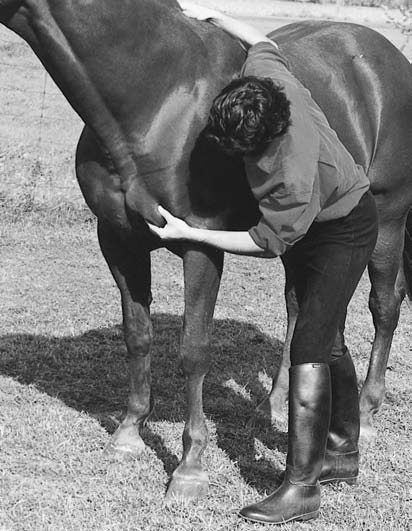
Massage Routines
141
6.27 Chest Work:
With muscle squeezing and
thumb kneading, interspersed with effleurage,
maintenance routine.
Warm up the back (point 6; figure 6.23), with the SEW
approach. Apply wringings up and down the spine to stimulate circulation. Intersperse with effleurages. Follow with light tapotements on the back muscles to reach deep into the muscle structures along the spine. Intersperse with effleurages every 30
seconds on average. Finger or palmar kneadings and light frictions will help loosen the fibers of the longissimus muscle group of the back. Drain thoroughly with the WES approach.
Moving to the gluteus and hamstring muscles (point 7; figure 6.23), use the SEW approach to warm up the area.Then use compressions interspersed with effleurages. Follow with tapotements and compressions to stir circulation and to loosen the fibers of these large muscle groups. Use thumbs, fingers, or palmar kneadings and gentle finger frictions along the length of the fibers of all the muscle groups of the hindquarters. Intersperse with effleurages toward the stifle.When done use the WES approach.
When applying the SEW approach over the hind leg, stroke down the hind leg (point 8; figure 6.23), and then effleurage upward toward the flank area. Then use gentle picking ups over the gaskin, plus muscle squeezings, kneadings, and gentle frictions,
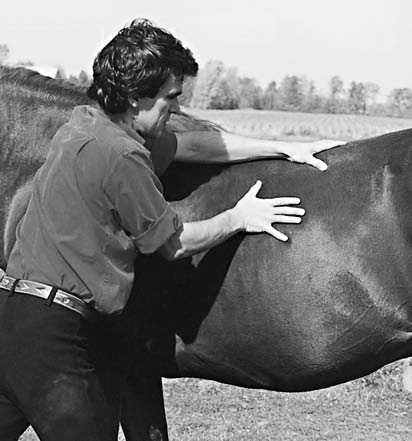
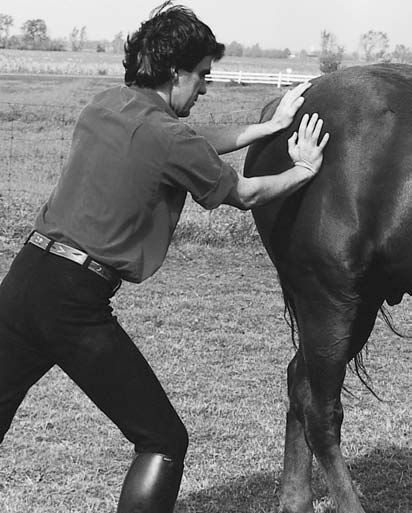
142
Equine Massage
6.28 Back Work:
With deep double-thumb kneading, interspersed with effleurage, maintenance
routine.
6.29 Hindquarter Work:
With deep palmar compression, interspersed with effleurage, maintenance routine.
Massage Routines
143
all interspersed with effleurages, over the fleshy part of the flexor and extensor muscle group of the hind leg. Drain thoroughly upward, starting from the top of the leg and working your way down. Once at the bottom of the leg, effleurage from the fetlock to the stifle in one long stroke; repeat to cover all aspects of the limb. Below the hock are only tendons, ligaments, joints, and bones. Gentle muscle squeezings, gentle frictions, and thumb kneadings will loosen the tendons and stimulate the blood circulation all the way down to the hoof; intersperse with effleurages going up the entire leg. When done, apply the WES approach to the entire leg,
With strokings, flow back to the thorax area (point 9; figure 6.23). Then use the SEW approach. Use large wringings interspersed with effleurages up and down the thorax 2 or 3 times. Use light kneadings between the ribs and intersperse with effleurages toward the heart.You can use large shakings to stimulate the circulation over the chest area. Do not do this to excess because it might be more stressful than enjoyable to the animal.You can consider using some tapotement moves such as light (3 to 5 pounds of pressure) clapping/cupping and hacking to reach deep stimulation of circulation. Follow with thorough effleurages. The skin rolling move is very efficient in keeping the skin and underlying fasciae loose.When done, apply the WES approach over the entire thorax.
Duplicate this sequence on the other side of the animal. The overall routine can last between 30 and 60 minutes, depending on your goal and the temperament of the horse. Keep it on the short side when in the early stage of massaging your horse. With repetition your horse will become more receptive to your massage work, and once he has become accustomed to it, it will not be unusual to see a maintenance massage routine last for an hour and a half.
The maintenance massage routine will give you feedback on the physiological state of your horse and will help you detect any small problems early and prevent them from becoming more serious. As you find trigger points, stress points, swellings, and inflammations, take notes and apply the appropriate techniques (chapter 5). Always follow with lots of effleurage.The maintenance routine is a wonderful tool for maintaining and increasing the horse’s performance. Regular use of the routine, at least once a week, will give you feedback on the quality of your training and will warn you of any potential problems. For highly trained horses, this routine should be applied at least every second day. Due to the frequency of the massage application, you will find that 20-to 30-minute sessions are sufficient to keep your horse in top shape.
144
Equine Massage
The Recuperation Routine
The recuperation routine helps avoid the buildup of lactic acid responsible for the formation of trigger points. This routine is intended to assist the lymphatic circulation (chapter 1) and speed up recovery time. For this purpose we will mostly use lots of effleurages, gentle wringings, and large thumb or finger kneadings, depending on the area you are working on.The recuperation routine is usually applied after heavy exercise but also at any time your horse shows signs of “stocking up” in the lower legs. If the lower legs appear swollen, apply cold hydrotherapy (chapter 4) before your treatment.
Lymph channels run everywhere in the body but are mostly located along the spine and the deep arteries.
Lymph nodes
(glands that act as filters to clean bacteria and unwanted particles) are found along the lymph channels. Lymph nodes are also found in patches at the junction of the limbs and the trunk on the inside of the legs (chapter 1, figure 1.4).
Hydrotherapy is very useful in this routine, as swollen nodes are very sore to the touch. If an inflammation is present, use cold to relieve the irritation. Otherwise, if there is no sign of inflammation, use the vascular flush or heat to relieve congestion and assist with circulation of the lymph fluid (chapter 4).
You must perform the recuperation routine very gently because you are dealing with irritated tissues and inflamed nerve endings.
Use mostly effleurage moves lightly over the tender areas with 2 or 3 pounds of pressure, 5 to 10 pounds on thicker muscle groups.
When no strong inflammation is present, you may use light vibrations or very gentle shakings over specific lymph node areas; these last two massage moves are very effective in decongesting and in stirring up circulation. Gentle thumb, finger, or palmar kneadings may be used to stir circulation in thick muscle areas.
Use a light (3 to 5 pounds) pressure around the leg joints with small, light, circular effleurages. In a recuperation routine, we drain the lymphatic fluid in the direction of the heart. But we must first decongest swollen and inflamed nodes before bringing more fluid to them.
Use cold hydrotherapy to soothe nerve endings and cool off the inflammation. If you have to deal with patches of enlarged lymph nodes, apply the swelling technique (chapter 5) to decongest them.
Start at the periphery of the nodes, using light circular effleurage and draining the nodes from the center toward the outside.
Recuperation Routine Outline
Connect with the animal for a few seconds by talking quietly and gently massaging the poll and the upper neck with light muscle squeezings.
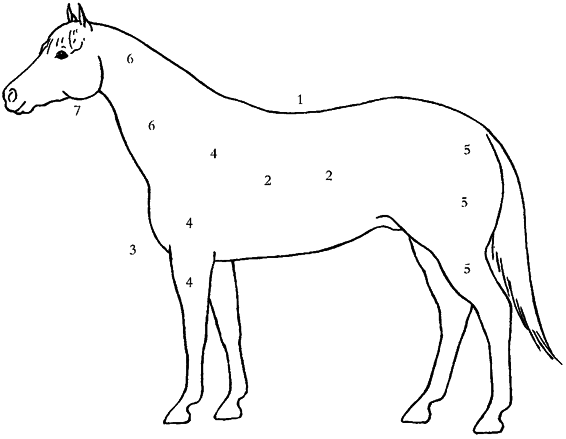
Massage Routines
145
Begin this routine at the withers (point 1; figure 6.30) on the left side. Use effleurages to drain along the entire spine all the way to the croup. Repeat 2 or 3 times.
Move to position yourself halfway between the fore-and hind legs of your horse (point 2; figure 6.30). Drain the thorax area with effleurages from the spine downwards along the rib cage.
Scoop the first half of the rib cage toward the inside of the foreleg, and the second half of the rib cage toward the inside of the hind leg. Repeat each aspect 2 or 3 times, and then duplicate this work on the other side of the horse.
Work the chest (point 3; figure 6.30) with lots of effleurages and light kneadings, draining downward, along the inside of the foreleg toward the heart.
Use gentle shaking moves on the large shoulder muscles (point 4; figure 6.30). Work the left leg by using effleurages, scooping toward the inside leg. Work progressively down the leg, draining it upwards. Because toxins may be found all the way down to the hoof, thoroughly drain the leg up toward the heart. Duplicate this work on the right leg.
Repeat this procedure on the hind legs. Be gentle when working over the tendons of the lower legs.
When working at the hindquarters of the horse (point 5; figure 6.30), move the tail to the side in order to reach the upper
6.30 Recuperation Massage Routine
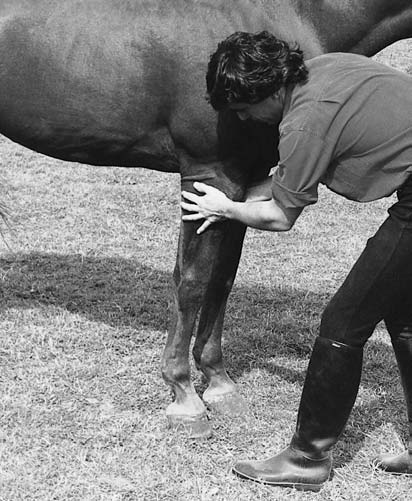
146
Equine Massage
attachments of the hamstring muscle groups. Scoop your effleurage movements toward the inside of the leg. In this location, if the patches of lymph nodes appear swollen and inflamed, first apply a cold towel to soothe the nerve endings and follow with a gentle swelling technique (chapter 5). Then proceed with effleurages over the horse’s back, scooping downward onto the chest. Massage all the way to the neck (point 6; figure 6.30). Spend some extra time draining the base of the skull and the top of the neck (behind the poll) thoroughly; use gentle muscle squeezings interspersed with effleurages. These moves will help drain the lymph nodes located in the upper neck.
